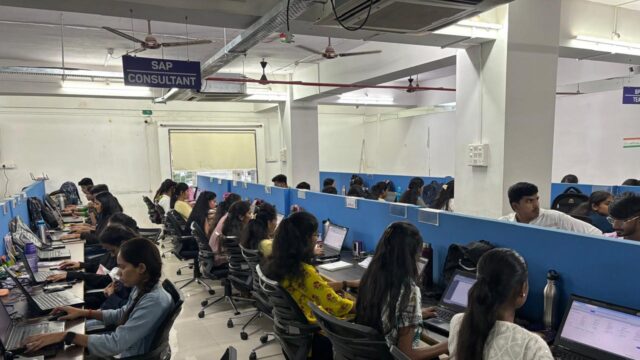Trump’s Trade Focus Muddles His Immigration Agenda

Lately, President Trump can’t seem to stop himself from making unwise comments about immigration. He reiterated his support for H-1B visas at the U.S.-Saudi Arabia Investment Forum last week, claiming it’s “MAGA” to bring in these foreign workers.
“They just don’t understand,” Trump said of his supporters who oppose these visas.
People have to be taught; this is something they’ve never done. But we’re not going to be successful if we don’t allow people that invest billions of dollars in plants and equipment to bring a lot of their people from their country to get that plant open, operating and working. I’m sorry.
The comments naturally caused unrest among the MAGA faithful. Along with his recent comments in support of Chinese student visas, Trump supporters are right to wonder what the hell is going on. How could the president claim this kind of immigration is “MAGA”? Trumpism is supposed to put Americans first.
Those comments are especially surprising given that his own administration is doing the opposite of what Trump suggests is needed. The White House has placed fees and other restrictions on H-1B visa applications. It’s instituting stricter rules on foreign workers staying here under the Optional Practical Training program (OPT). It’s these very policies that are discouraging foreign students from coming here.
So what’s going on with the president? The most likely answer is that his laser focus on trade deals is clouding his rhetoric. Many of the countries he’s negotiating with want their citizens to continue to migrate to America. Trump, apparently caring more about maintaining a barrier to foreign products than foreign nationals, appears to be catering to these sentiments. In other words, he’s willing to prop up H-1Bs and student visas in order to make trade deals.
That should concern right-wingers. Limiting immigration matters more than random tariffs on Korean goods. The administration needs to get its priorities straight if it wants to make America great again.
Many of the countries with which Trump engaged in trade negotiations this year demanded guarantees that their citizens could still migrate to the U.S., whether on student or H-1B visas. China, in its ongoing negotiations, insists that America allow its people to obtain student visas as part of any trade deal. While other proposals have been rejected, this one appears to have been accepted by Trump.
India’s ministers are pushing the administration hard in its negotiations to allow tens of thousands of Indian workers into the country. South Korea raised immigration in its trade talks with Trump. The country was particularly incensed over its citizens being arrested and deported after they illegally migrated to work at a Georgia factory.
That incident now serves as Trump’s primary pitch for H-1Bs. In his disastrous interview with Laura Ingraham earlier this month, he said the following about the detained Koreans in Georgia:
In Georgia, they raided because they wanted illegal immigrants out. They had people from South Korea that made batteries all their lives. You know, making batteries are very complicated [sic]. It’s not an easy thing and very dangerous. A lot of explosions, a lot of problems. They had like five or six hundred people, early stages, to make batteries and to teach people how to do it. Well, they wanted them to get out of the country. … You can’t just say a country’s coming in, going to invest $10 billion to build a plant and take people off an unemployment line who haven’t worked in five years and they’re going to start making them missiles. It doesn’t work that way.
He repeated this point about the South Korean battery factory in Georgia in his talk at the U.S.-Saudi Investment Forum. He added a new line, however, pointing to Taiwan’s semiconductor industry as yet another example of the need for “skilled” foreign workers. “I don’t think you can open up a big plant with your friend from Taiwan, where we’re going to have 40 to 50 percent of the computer chip business, I don’t think you can do that with people who don’t even know what a computer chip looks like,” he said. He had also mentioned Taiwan to reporters just a few days earlier, arguing that we need foreign workers to bring the semiconductor industry here.
Trump wants manufacturing to return to the U.S. The issue is that he doesn’t seem to care where the workers come from. What’s important is that they are working in America, not that they are Americans. It may seem America First to Trump, but it doesn’t seem that way to many of his supporters.
This sheds light on Trump’s particular brand of economic nationalism. For decades, he’s warned that foreign countries are ripping America off and that our leaders need to put an end to it through high tariffs. In Trump’s view, America had gone from a winner to a loser due to bad trade deals and stupid leaders. He pledged to make America win again as president. These are sentiments nearly all American nationalists share.
What differentiates Trump from others, however, is that he’s less wedded to the need for Americans to be working these jobs. Trump wants America—as a state and an economy, not so much as a people—to win. This mentality usually means the people win as well. But this is not guaranteed in all cases. Advocating for H-1Bs to take American jobs is an example of a wrongheaded hope that it will make the country “win.” It won’t.
Trump loves deals. He wrote a whole book about the subject. If he views making concessions on immigration as a way to make deals with foreign countries, he’ll do it. What matters, from his point of view, is securing an agreement he thinks is favorable to the long-term interests of America. For Trump, that appears to mean more limits and duties on foreign products than on foreign people.
The president also seems to believe he has exclusive ownership of the MAGA movement. That’s an understandable opinion for him to have, since he was the one who created it and made it what it is today. He’s endured a great deal to get where he is now. Still, there is more to MAGA than Trump’s own whims, and he wouldn’t be where he is without the people who voted for him. The people voted in 2024, above all, to curb immigration. From their point of view, a trade deal isn’t much of a win if it results in Chinese students taking spots in elite U.S. universities and Indian tech workers taking jobs from Americans.
Of course, these few bad statements don’t mean that Trump has done a complete flip on immigration. His administration is still cracking down on both legal and illegal immigration. We’ve witnessed at least 2.2 million migrants leave the country since Trump took office. Border crossings are at record lows. Unfortunately, Trump is open to making carve-outs when foreign countries realize it’s up for negotiation.
MAGA wouldn’t exist without Trump. But that doesn’t mean MAGA should blindly follow Trump on every single issue. When the president goes against the spirit of his own movement, it’s right to call him out. A steady drumbeat of criticism will persuade Trump to abandon his H-1B dalliance.
https://chroniclesmagazine.org/web/trumps-trade-focus-muddles-his-immigration-agenda
